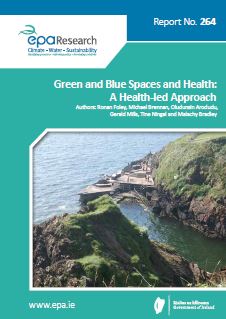Authors: Ronan Foley, Michael Brennan, Oludunsin Arodudu, Gerald Mills, Tine Ningal and Malachy Bradley.
Summary: This research was based on a 12-month desk study that modelled, for identified sample sites, the relationships between health indicators and the availability of green and blue infrastructure (GBI). It provided a route to identify measurable effects and results from a cross-sectional and area-based study.

Ireland is faced with a generally healthy although ageing population. However, public health concerns have been expressed about high levels of obesity and increasingly sedentary lifestyles as being contributors to potentially declining future public health outcomes. One research area identified as having the potential to combat such pressures has been the health potential of natural environments, expressed here as green and blue infrastructure (GBI).
The literature identifies generally strong positive relationships between access to and the availability of GBI with better health and well-being indicators. This study addresses these pressures through spatial (geographical) modelling in Ireland, looking at identifying a measureable effect from the relationships between different indicators of health and levels of GBI. Unlike other studies, we consider this pressure from a health-led position, with a core focus on the health end of that health/environment equation.
Using innovative Geographic Information Systems (GIS), spatial modelling and statistical analysis, this study identifies evidence for the direct relationships between the presence of GBI and a number of health indicators, including self-reported health, mortality and disability, with additional mediation from deprivation. The health indicators used in the study were focused on publicly available data at a range of aggregated spatial scales, from small area up to county level. In addition, the report provides a critical data audit on both barriers to and positive suggestions on ways to develop a fuller public evidence base for area-based health research. The findings will inform a number of national agencies and service providers, including the Health Service Executive, the Department of Health and the cross-departmental Healthy Ireland initiative.
Using statistical modelling for a small number of sample areas against two different GBI datasets, this report documents magnitudes of associations of GBI elements with health status. It also identifies a pathway for further work in two ways: first, by demonstrating techniques to collate, overlay and aggregate health data across different scales of analysis, and, second, by providing a critical analysis on the availability of health data, with an emphasis on gaps and access issues, but also opportunities associated with the rapidly developing availability of health data. The report directly suggests the need for a new intermediate area geography for the reporting of health data in Ireland that would be mutually acceptable to data holders and data users.
https://www.epa.ie/media/epa-2020/publications/research/Research_264_Thumbnail[1].jpg